Okay, so maybe ten years is an exaggeration, but why do the majors' feature films take so long to make? Evan Backes investigates.
Act I | Scene I
Brilliant animated feature film idea composed. The studio's buzzing, the chairman wants to see some designs, and the top, top talent is hired at great expense.
Act I | Scene II
Concept drawings are finished. The studio decides what type of animation will be both profitable at the box office and what will ultimately cut costs in the long run. Voice actors -- and mega stars -- are called up.
Act II | Scene I
The chairman sees the rough work and decides it's rubbish, asks the production team to come up with a "better solution."
Act II | Scene II
The lead creative talent becomes frustrated and leaves for a different project. Production is shut down for 5 months. The studio eventually decides to reassess their options according to the financial outlook.
Act II | Scene III
A new team with a "fresh attitude" is located and hired. The title of the picture is changed. The overall aesthetic of the film is thrown out for a new look, feel and sensibility. One that should have been taken all along...
Act II | Scene IV
A marketing strategy is launched to cover-up the years of mistakes.
Act III | Scene I
The film is released to mixed reviews, lackluster box office results and happy children.
Act III | Scene II
The studio plunges into pre-production on their next film. Should it be a sequel? A re-hash of an "evergreen" property?
Act III | Scene III
All of us enthusiasts sit back and keep shaking our heads.
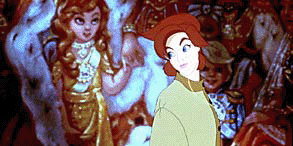
An 18 year-old peasant girl named Anya does not realize she is standing in front of her own portrait at the former Romanov palace. © 1997 Twentieth Century Fox. All rights reserved.
The year was 1997. Anastasia was about to be released and every studio big and small wanted to produce an animated film. Executives had found that animated features could be as profitable as live-action films back when The Little Mermaid and The Lion King were released, but it wasn't until the mid to late Nineties that any of these new studios stood up to the plate. On the surface it would appear that animation had finally broken the mold, a new day was born where animators could look forward to working in a prosperous environment. However, in the rush to the starting gate there have been many false starts and stops that have put a damper on the entire industry.
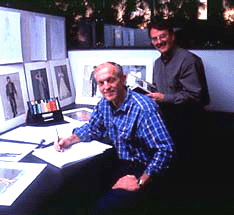
Don Bluth (seated) and Gary Goldman produced and directed Anastasia and later Titan A.E. © 1997 Twentieth Century Fox. All rights reserved.
If one were to follow the production of any animated film, the results would surprisingly act out much like a dramatic play. Why is it taking a studio five years to produce a film that could have been completed in two and a half max? Other films are being rushed to the screen like a rabbit on speed. Why does story take years -- and sometimes months of production -- before being re-worked and nailed down? Why are these films greenlit before this has happened? Why is animation completed before this happens? Can we only rely on John Lasseter, Brad Bird and Nick Park for brilliant films these days? And even if they do their best, they are at the mercy of the studio that puts together the final marketing and advertising plan. Animation has the wonderful capability to do just about anything the mind can fathom. However, when there isn't a capable script, a talented (and unfettered) crew and the studio punch behind the product, the final box office figures will show justly.
This new world of animated features has raised the stakes for studios, and along with the possibility of big wins, and losses, comes second guessing and constant tweaking. Let's uncover the history of a few animated projects. We've all seen the final results. Now, what did it take to get there?
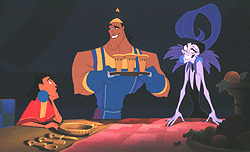
The Emperor's New Groove went from a drama to a wacky, light-on-its-feet comedy. © Disney Enterprises, Inc. All rights reserved.
The Emperor's New Groove
Early 1997: A new Disney feature slated for a 1999 release entitled, Kingdom of the Sun is in the pre-production stages. It's supposedly a sweeping South American tale based on the old fable of The Prince and the Pauper.
Fall 1997: The project has been greenlit. Roger Allers (co-director of The Lion King) and Mark Dindal (director of Cat's Don't Dance) are chosen to direct the film. Brilliant animator Andreas Deja is also put on the team.
Fall 1998: After a year into the project and almost a third of the picture completed, the production studio becomes a minefield. The suits take a gander at the story reel and discover this is the worst Disney film in decades, despite the fact that it had been accepted months ago. The production is put back into development and Roger Allers leaves the project due to problems with his co-director, taking Andreas Deja with him.
February 1999: For months now the production on Kingdom of the Sun has been put almost to an utter halt. Disney threatens to close down production due to high costs.
Summer 1999: An entirely new script is written. Dindal is working on this project solo now. Production slowly creeps out of the woodworks, however, the executives keep the budget extremely tight. Voice actors Owen Wilson, Harvey Fierstein and Trudie Styler are thrown to the wayside; David Spade, John Goodman and Patrick Warburton get ready for rehearsals. The new film is slated for a Fall 2000 release.
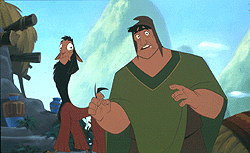
Despite ominous pre-release rumors, Kuzco and Pacha's antics carried Disney's latest quite well at the box office. © Disney Enterprises, Inc. All rights reserved.
February 2000: The film's title has been changed to The Emperor's New Groove. Everyone gawks at the change.
July 2000: The trailer is released and anybody who followed the production of the film is strangely surprised. No more sweeping landscapes, no more Aztecan culture, just one slapstick joke after another. The huge marketing campaign begins.
December 15, 2000: The Emperor's New Groove is released into theatres with a generally positive showing. With a total budget of $100 million, the film, as of the end of March, has just under $90 million in domestic box office. Most films don't make $90 million! This should be regarded as a hit, but strangely it isn't. The film had some great moments, but I couldn't help wonder how quickly and cost effectively Disney could have pulled this off if only they had decided on this script back in 1997.
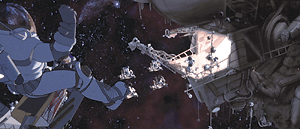
Fox Phoenix's swan song, Titan A.E. © 2000 Twentieth Century Fox. All rights reserved.
Titan A.E.
Spring 1997: Fox's second animated film originally titled, Planet Ice is greenlit. Art Vitello is brought on to direct the film. All reports are that the film will contain cutting edge CGI imagery.
February 1998: Art Vitello leaves the project.
May 1998: Ten development personnel and artists involved in pre-production are given lay-off notices. Division president Chris Meledandri explains, "The film was never in production. It is still in pre-production." He adds that the studio "currently has a very small crew on the film," which is in the process of "finding out exactly how they are going to make it." Later in the month, the film, the majority of which is still being done in computer animation, is now being directed by Blue Sky|VIFX staffers Henry Anderson and Chris Wedge.
Fall 1998: Veterans Don Bluth and Gary Goldman (An American Tail and Anastasia) take over the production. The film takes a new aesthetic direction and is now being made digitally with a mix of traditional animation as opposed to CGI animation. Transferring the production from Blue Sky|VIFX to Fox's state-of-the-art Phoenix studio, most of Blue Sky's work is cut. Artists are imported to Phoenix from as far away as Ireland and the Philippines. Bluth and Goldman are given a ridiculously short nineteen-month deadline and a budget of $55 million.
Spring 1999: Title is changed from Planet Ice to Titan A.E.
February 2000: After a little more than a year's work on the film, more than 300 of the animators who were relocated to the Arizona studios are laid off. The remaining 66 workers are later terminated when production ceases on the film. Shortly after the Arizona studio is shut down.
June 16, 2000: After meeting the grueling schedule, Titan A.E. is released to theatres to come in fifth place at the box office during its first weekend. Fox executives shrugged their shoulders when it came time to marketing the film. The film barely made over $20 million in the United States.
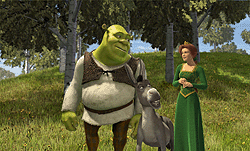
All eyes will definitely be on this trio May 18, 2001 when Shrek opens across the U.S. TM and © 2001 PDI/DreamWorks.
Shrek
Late 1996: Shrek is greenlit and is sent into pre-production. Kelly Ashbury and Andrew Adamson are slated to direct.
Spring 1997: A 30-second demo reel is produced by an unknown motion-capture production house and is shown to Jeffrey Katzenberg. "Disappointing" was the word he used. A skeleton crew is left to produce another demo reel and dozens of animation houses are scouted for the next six months.
Fall 1997: Katzenberg ultimately decides to switch production over to Pacific Data Images, which is in the midst of working on Antz.
Winter 1997: The film seems to hit rock bottom when Chris Farley -- the voice actor for the main character -- suddenly dies at the age of 33. Mike Myers is later cast to fill in for Farley.
Spring 1998: Most of the script is retooled and for the most part, production is back in the storyboard phase. Janeane Garafolo is replaced by Cameron Diaz as the leading voice actress. John Garbett steps down as the film's producer to be replaced by Aron Warner (Antz). A summer 2000 release is scheduled.
Fall 1998: Co-director Kelly Ashbury is transferred to direct DreamWorks' follow-up animated film Spirit, and is replaced by Victoria Jensen (Ferngully: The Last Rainforest).
Fall 2000: After almost three years, the first trailer is presented to the public. It is now obvious that the production team wouldn't be hitting their mid-2000 deadline.
Spring 2001: Now we're all waiting for the big May 2001 release date and there's been no sign of any marketing campaigns beyond the occasional trailer and movie poster...time will tell...
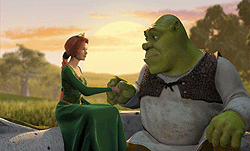
Many in the animation community hope Shrek's love story of an ogre and a princess can re-kindle the ailing animated feature film market. TM and © 2001 PDI/DreamWorks.
Hopefully, the industry's commitment to animated features will survive these growing pains, and from these setbacks and victories, the process of animation will survive the fact that it became Hollywood's latest craze. The above films, I suppose, should consider themselves lucky as they have managed to see the light of day, unlike Warner Bros.' The Incredible Mr. Limpet and Universal/ILM's The Animated Frankenstein Project. The last few years have been an incredible learning experience, not necessarily for the artists creating the films, but everyone else surrounding the process. Apparently, our party isn't one that is easy to join.
Evan Backes, the creator of the late Stay Tooned (www.staytooned.com), is now pursuing an interest with graphic design at Avant Guardian (www.avant-guardian.com).







